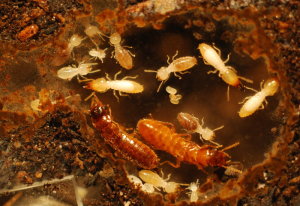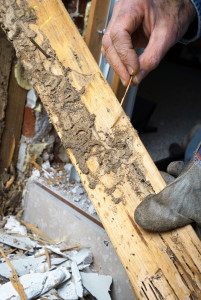The unseasonably warm weather we are having in Sacramento and Northern California has tricked lots of plants and trees into an early bloom, from daffodils to almonds. Such springlike weather may also mean another, less attractive early season—namely termite swarms.
 Last March we got a frantic call from one of our pest control customers: she had just had a panicked call from her teenage daughter, who had arrived home from school to find the living room carpet swarming with termites. Our customer acted quickly—she told her daughter to get out the vacuum and start sucking up the bugs, then got on the phone to us.
Last March we got a frantic call from one of our pest control customers: she had just had a panicked call from her teenage daughter, who had arrived home from school to find the living room carpet swarming with termites. Our customer acted quickly—she told her daughter to get out the vacuum and start sucking up the bugs, then got on the phone to us.
Three types of termites are active in our Sacramento pest control region—dampwood termites, drywood termites and subterranean termites.
Although dampwood termites, which live only in wet or moist wood, can be found anywhere in California, they are more prevalent in damp, cooler coastal areas. When we do see them in structures in our area, it usually is an indicator of a moisture problem such as a leaky hot water heater or water line.
Drywood termites attack dry, sound wood, everything from dead trees and fencing to structural timbers and even furniture.
Subterranean termites, which are common throughout California, live in wood that has contact with the soil, such as fallen trees, or the structural wood in our buildings.
The most common species of termite in the Sacramento area is the Western Subterranean Termite. Although it is smaller than drywood or dampwood termites, it is the most destructive termite in California, according to the University of California Statewide IPM Program, due to the huge colonies it forms. A 2,400-square-foot home, for example, could sustain several termite colonies, each containing hundreds of thousands of individual termites. Because subterranean termites live below ground and inside wood, they are often impossible to detect unless a swarm occurs or a “shelter tube”—a mud tube formed by worker termites by mixing saliva with dirt, wood or bits of drywall—is spotted.
One reason the number of termite complaints goes up as the days grow warm in the spring is that warm weather triggers many termite species to swarm, which is how they reproduce and spread from structure to structure. In large termite colonies, a small number of termites, called alates or swarmers, develop wings, fly off in a swarm, mate, nest and form new colonies. Sometimes the sight of swarming termites is the first sign a property owner sees of a termite infestation.
Each type of termite—dampwood, drywood and subterranean—must be treated differently, and do-it-yourself remedies generally are not effective. Pesticides used in termite treatment are strictly regulated, and most are restricted to use by pest control professionals. At Pinnacle Pest Control, we offer a complete package of termite solutions, including detection, identification, prevention and elimination, each targeted to the specific type of infestation, customized to each location, and aimed at minimizing the environmental impact. So just in case warm spring weather brings a swarm of unwelcome guests to your home, don’t panic; just give us a call.



